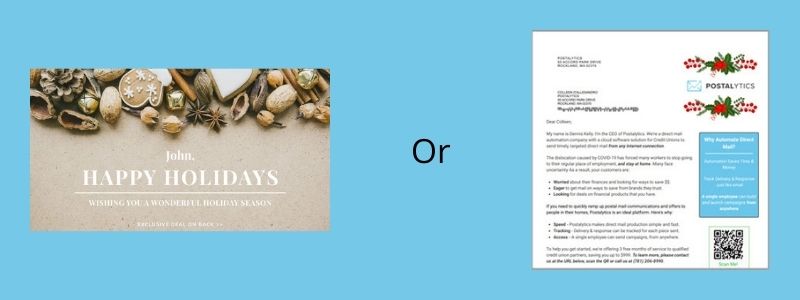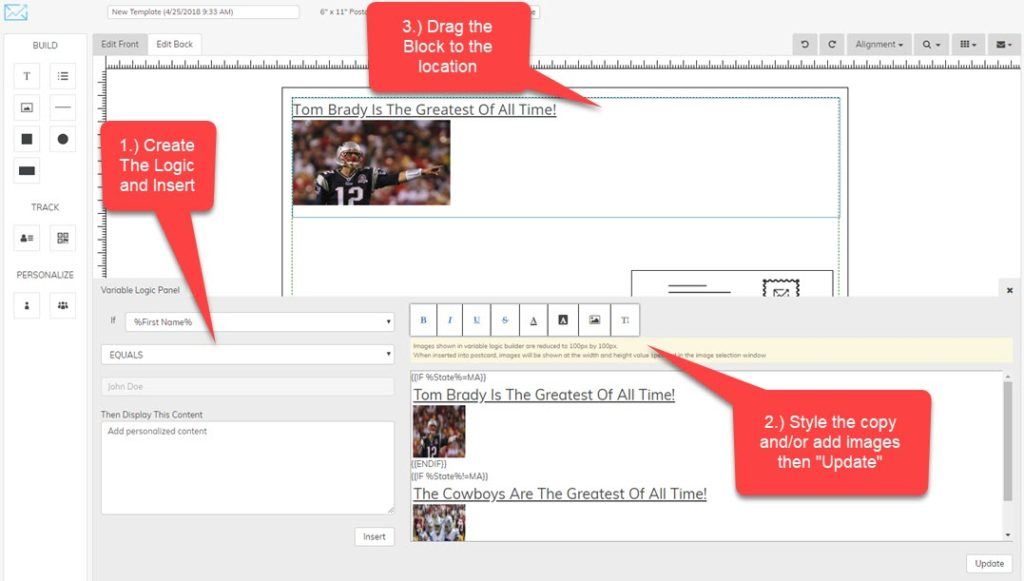
Do you remember the most recent year end thank you message you received via email?
Most of the holiday or year-end thank you messages of goodwill and appreciation we all receive from companies are pretty sad. One gets the impression that someone at the company decided they needed to send something to their customers at the end of the year. They slapped together some meaningless text, merged it with the email list, and let it go. The messages are the same year after year.
Emails with subject lines like “Season’s greetings from …”, “Our best holiday wishes to you”, or “Thank you for your business” produce below-average open rates. Everyone thinks they know what those messages are going to say, so they don’t even bother to open them.
It doesn’t have to be that way. Here are some ideas to make your end-of-year communications stand out and positively impress your customers.
Table of contents
- Is Email Really The Best Way?
- Should I Send a Postcard, a Bifold Self-mailer or a Letter?
- Make Sure It Gets There: Data Quality Matters
- Personalization: Explicit Data Use
- Personalization: Segmentation
- Test Your Personalization with Digital Proofs
- 12 Do’s and Don’ts: What to Write in Your Year End Thank You Message
Is Email Really The Best Way?

The communication channel used by most companies is the first problem. Years ago, companies sent actual greeting cards. Yes, many of them were generic corporate cards, but unlike emails, most of them still got opened.
Now, most companies send a year end thank you message or season greeting via email. The messages compete for attention with not only the regular slew of email communications that hit customer in-boxes, but similar year-end emails from everyone else with whom they do business. Marketers have overused the email channel and getting attention is an enormous challenge.
If you’re serious about making an impression with your year end thank you message, try sending physical mail instead of going with email again this year. Your customers will appreciate the effort and recognize the extra investment you’ve made to reach out to them in a way most companies do not.
In fact, studies show that consumers trust direct mail far more than digital channels.
Postal mail has lots of advantages:
- Customers receive far fewer daily messages
- Not limited to a short subject line to get customer’s attention
- No spam filters
- Perception of value is much higher. Because it is more valuable.
- Interesting pieces almost always get opened or looked at
Postalytics can help you create year-end messages that not only get attention from your customers but also make a positive impression. Direct mail automation makes it the same amount of work as an email, and the bigger impact make it worth spending a little more.
Should I Send a Postcard, a Bifold Self-mailer or a Letter?

Choosing the format of your year-end thank you message is an important first step. Postcards and letters each have strengths that you should consider before selecting the format.
Why choose a letter for your year-end thank you?
- You are communicating a message from an executive
- Your message should be delivered with a bit of formality
- You have a lot to say, you don’t want to “cram” into a postcard
Why choose a postcard?
- Your creative features powerful images to help convey your message
- You can communicate your primary message with headlines
- You’d like your message delivered without an envelope
Why choose a bi-fold self-mailer?
- You’d like to leverage the expansive real estate of a letter, but
- You also would like to use large images to convey your message
- You’d like your message delivered without an envelope
We see clients choosing both letter and postcard (typically 6×9 or 6×11) formats and bi-fold self-mailers and doing a great job with them. There isn’t a huge difference in cost, so be sure to pick the format that makes the most sense for your creative approach.
Make Sure It Gets There: Data Quality Matters

To send your year-end thank you message to customers through the mail, your database must contain current postal addresses. Many companies, having migrated all their communications to digital delivery, cease efforts to update customer addresses in their CRM systems and their data is obsolete. Experts estimate the accuracy of unmaintained customer data degrades at a rate of about 2% per month.
You will waste all the time and effort you spend creating personalized printed communications if the US Postal Service cannot deliver your messages to the intended recipients. If your records have no postal address information, connect with companies that can append this data for you. Given a name, phone number, or even only an email address, these services can find matching postal addresses to update your records.
Postalytics customers who need help with appending postal addresses can ask their Postalytics account representatives. We’ll be happy to refer you to firms that can handle these tasks for you.
If you have not continuously updated your files, many customer mailing addresses may be unreliable. According to the US Census, about 14% of the population moves every year. Even if they don’t move, renamed streets and new zip codes can change the address of a family or business. To update your data, your customer file must be processed through official USPS databases to check for address accuracy and move updates. Postalytics automatically processes our customer’s data files before mailing to ensure the mail contains updated addresses.
While you are cleaning up your addresses, check the quality of other customer data. Check to make sure data fields you will reference in your year-end greeting are present and accurate. Consider data items such as first name, last name, company name, title, gender, customer type, and loyalty data. Populate blank data fields with default values. Get rid of duplicates. Misspellings, blanks, or case errors (Macdonald, Ibm Corporation, or ALL CAPS) will destroy the impression you want to make with your printed thank-you messages, so fix the data first.
Personalization: Explicit Data Use

Personalization can come in many forms, from using a person’s name to customizing the messages themselves. If your customers are businesses, we recommend you direct your year-end thank you message to customer executives and principal contacts, rather than to the company.
The same applies to business partners and vendors with whom you do business with. Employee names and addresses should be easily attainable.
To personalize your year-end postcards and letters, use data from your CRM, customer database, Accounts Payable and HR systems. You can directly import some lists using Postalytics integrations, and others you can export to .CSV files for import.
You can use this data to populate passages such as “We value the relationship we’ve had with %COMPANY% since %CUSTOMER_SIGNUP_YEAR%”. The more comprehensive (and correct) your data, the more you can personalize the text by inserting explicit variables.
You can easily incorporate variable data in your year-end letter or postcard with Postalytics. Use the Postalytics Direct Mail Editor to set this up. You can even designate customer photos as variables. Examples might include a car dealer that photographs each buyer as they are taking delivery of their new vehicle.
Here’s a video that demonstrates this operation:
For more information, check out the Postalytics documentation for “Variable Data”.
Personalization: Segmentation

Don’t let you year-end thank you message fall into the one-size-fits-all approach from the old days. Segment your customer file and compose text that pertains to each segment. If, for example, your landscaping company serves both residential and commercial customers, the terminology and items discussed will probably differ for each group.
Or perhaps you want to speak to your gold level customers differently than the bronze or silver customers. Long-term customers deserve recognition of their loyalty but the words you use to express your appreciation for newer customers may speak of your anticipation of a long and prosperous relationship. Perhaps your year-end thank you message will differ depending on the geographic location of the customers. A national pest control company might mention termites and fire ants in one region, but carpenter ants or invasive beetles in another. The possibilities for personalization are endless.
Postalytics handles personalization such as this with a function called the Variable Logic Editor. You can create and design a postcard or letter and use variable logic to control which text blocks or images display on individual mailpieces.

Variable substitution is accomplished with simple condition statements that inspect the value of data fields and then insert the corresponding content. For example, your letter or postcard template may include a statement such as “IF %STATE%=AZ”. Following this condition statement may be a photo of a desert landscape. The next condition may be “IF%STATE%=WA” followed by a photo of an evergreen forest.
With this powerful capability, you can create a year-end message that includes paragraphs or other elements that pertain only to certain groups. Customers will recognize the communication as being more personal. These communications are much more effective than the generic corporate greetings most companies send their customers at this time of year.
Test Your Personalization with Digital Proofs
As with any project that involves variable data, be sure to test. Postalytics has a built-in direct mail “Proofer” to help you test using your live data.
Run some data through the process and make sure each variable combination results in the intended content. Look for data exceptions, such as extra-long data values that cause formatting problems. Make sure default values are used properly when data fields are blank. Ensure that text and graphics are consistent with what you know about each customer.
12 Do’s and Don’ts: What to Write in Your Year End Thank You Message

You can use the personalization techniques described to create year end thank you message that will have a much greater impact than the generic emails you probably sent last year. But what should you say in these types of messages? And, just as importantly, what should you NOT say?
The content of every company’s messaging will differ, and much depends on the culture and image of the brand. Some can use humor, others cannot. Our best advice is to write with gratitude. Remember, you are thanking your customers for their business, not trying to sell them something more. Write like a person and show empathy and appreciation, and you’ll be fine.
Here are some basic thank you letter do’s and don’ts:
DO personalize as much as possible. The extent of personalization will depend on the availability of accurate data and the project scope.
DO express your gratitude for the customer’s business and the trust they have put in your company.
DON’T promote. Fight the urge to include business cards or a discount offer. You can invite customers to contact you with questions, but you shouldn’t be looking at year-end thank you messages as an opportunity to connect. Unless it’s a totally selfless suggestion like joining your company in supporting a charity, there’s no call to action here.
DO be genuine. Avoid over-the-top declarations of your appreciation.
DON’T get too personal. While personalization is more beneficial than generic content, don’t cross the line into creepy by being too explicit.
DO make your message consistent with your organization’s personality. If your company is a strait-laced business, adding flowery prose or images would confuse the customers.
DO tell customers what their business means to you, without touting your record profits or other self-serving details. Charities are the exception here. It’s a good idea to let donors know about the good deeds your charity has performed because of their donations.
DO include specific details if you can. If your data allows it, mention a detail like purchase activity or a completed project that shows this message is unique for the customer that receives it. Note: If your data is inaccurate or incomplete, it’s best to avoid explicit references.
DO refer to the future with phrases like “We look forward to working with you on your next project”.
DO end the communication with the signature of an executive or other actual person from your organization.
DON’T write like a corporation. Avoid corporate-speak and write as if you were talking to an individual on the phone. Professional vs. casual tone depends on your brand image.
DON’T let your messages go out without proofreading for spelling, content, and grammar. Use the Postalytics proofer to help walk you through this. Have someone else read it and give feedback if possible. If you’re on your own, read the message out loud a day after writing it. You’ll probably find some areas to improve.
Your year-end thank you message shouldn’t be just a check-the-box task. If you’re going through the trouble to do them, make them impactful and memorable by investing in postal mail and creating something important.
About the Author

Dennis Kelly
Dennis Kelly is CEO and co-founder of Postalytics, the leading direct mail automation platform for marketers to build, deploy and manage direct mail marketing campaigns. Postalytics is Dennis’ 6th startup. He has been involved in starting and growing early-stage technology ventures for over 30 years and has held senior management roles at a diverse set of large technology firms including Computer Associates, Palm Inc. and Achieve Healthcare Information Systems.
